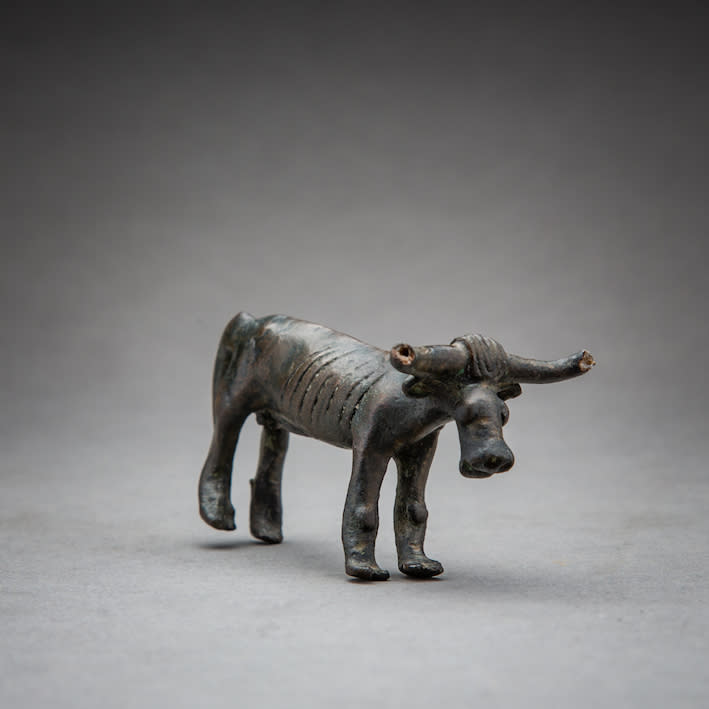Indus Valley Bronze Bull, 3000 BCE - 2000 BCE
Bronze
5.1 x 9.7 cm
2 x 3 3/4 in
2 x 3 3/4 in
AM.0401
Further images
The Indus Valley civilization was rediscovered in 1920-21 when engraved seals were unearthed in the Punjab province of Pakistan at a site called Harappa, a name which is often used...
The Indus Valley civilization was rediscovered in 1920-21 when engraved seals were unearthed in the Punjab province of Pakistan at a site called Harappa, a name which is often used to describe the civilization as a whole. Subsequent excavations at Harappa revealed the size and complexity of this ancient city. Other sites were unearthed as well along the banks of the Indus River, including the equally large city of Mohenjodaro. Through archaeological and historical research, we can now say for certain that a highly developed urban civilization flourished in the Indian subcontinent over five thousand years ago. Though the Indus Valley script remains undeciphered, the numerous seals, statuary, and pottery discovered during excavations, not to mention the urban ruins, have enabled scholars to construct a reasonably plausible account of the Indus Valley civilization.
Some kind of centralized state, and certainly fairly extensive town planning, is suggested by the layout of the great cities of Harappa and Mohenjodaro. The same kind of burnt brick appears to have been used in the construction of buildings in cities that were several hundred miles apart. The weights and measures also show a very considerable regularity, suggesting that these disparate cities spread out across a vast desert shared a common culture. The Indus Valley people domesticated animals, and harvested various crops, such as cotton, sesame, peas, barley, and cotton. Indus Valley seals have been excavated in far away cities such as Sumer, suggesting that a wealthy merchant class existed, engaged in extensive trading throughout the subcontinent and the Near East.
Other than the archaeological ruins of Harappa and Mohenjodaro, these seals provide the most detailed clues about the character of the Indus Valley people. Bulls and elephants appear on these seals, but the horned bull, most scholars agree, should not be taken to be congruent with Nandi, for the horned bull appears in numerous Central Asian figures as well. The women portrayed on the seals are shown with elaborate coiffures, sporting heavy jewelry, suggesting that the Indus Valley people were an urbane people with cultivated tastes and a refined aesthetic sensibility. A few thousand seals have been discovered in Indus Valley cities, showing some 400 pictographs: too few in number for the language to have been ideographic, and too many for the language to have been phonetic.
Some kind of centralized state, and certainly fairly extensive town planning, is suggested by the layout of the great cities of Harappa and Mohenjodaro. The same kind of burnt brick appears to have been used in the construction of buildings in cities that were several hundred miles apart. The weights and measures also show a very considerable regularity, suggesting that these disparate cities spread out across a vast desert shared a common culture. The Indus Valley people domesticated animals, and harvested various crops, such as cotton, sesame, peas, barley, and cotton. Indus Valley seals have been excavated in far away cities such as Sumer, suggesting that a wealthy merchant class existed, engaged in extensive trading throughout the subcontinent and the Near East.
Other than the archaeological ruins of Harappa and Mohenjodaro, these seals provide the most detailed clues about the character of the Indus Valley people. Bulls and elephants appear on these seals, but the horned bull, most scholars agree, should not be taken to be congruent with Nandi, for the horned bull appears in numerous Central Asian figures as well. The women portrayed on the seals are shown with elaborate coiffures, sporting heavy jewelry, suggesting that the Indus Valley people were an urbane people with cultivated tastes and a refined aesthetic sensibility. A few thousand seals have been discovered in Indus Valley cities, showing some 400 pictographs: too few in number for the language to have been ideographic, and too many for the language to have been phonetic.







